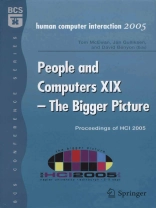As a new medium for questionnaire delivery, the Internet has the potential to revolutionize the survey process. Online (Web-based) questionnaires provide several advantages over traditional survey methods in terms of cost, speed, appearance, flexibility, functionality, and usability [Bandilla et al. 2003; Dillman 2000; Kwak & Radler 2002]. Online-questionnaires can provide many capabilities not found in traditional paper-based questionnaires: they can include pop-up instructions and error messages; they can incorporate links; and it is possible to encode difficult skip patterns making such patterns virtually invisible to respondents. Despite this, and the emergence of numerous tools to support online-questionnaire creation, current electronic survey design typically replicates the look-and-feel of pap- based questionnaires, thus failing to harness the full power of the electronic survey medium. A recent environmental scan of online-questionnaire design tools found that little, if any, support is incorporated within these tools to guide questionnaire design according to best-practice [Lumsden & Morgan 2005]. This paper briefly introduces a comprehensive set of guidelines for the design of online-questionnaires. It then focuses on an informal observational study that has been conducted as an initial assessment of the value of the set of guidelines as a practical reference guide during online-questionnaire design. 2 Background Online-questionnaires are often criticized in terms of their vulnerability to the four standard survey error types: namely, coverage, non-response, sampling, and measurement errors.
قائمة المحتويات
H — HCI at the Human Scale.- “Looking At the Computer but Doing It On Land”: Children’s Interactions in a Tangible Programming Space.- The Usability of Digital Ink Technologies for Children and Teenagers.- PROTEUS: Artefact-driven Constructionist Assessment within Tablet PC-based Low-fidelity Prototyping.- The Reader Creates a Personal Meaning: A Comparative Study of Scenarios and Human-centred Stories.- What Difference Do Guidelines Make? An Observational Study of Online-questionnaire Design Guidelines Put to Practical Use.- Designing Interactive Systems in Context: From Prototype to Deployment.- Using Context Awareness to Enhance Visitor Engagement in a Gallery Space.- Engagement with an Interactive Museum Exhibit.- User Needs in e-Government: Conducting Policy Analysis with Models-on-the-Web.- Fit for Purpose Evaluation: The Case of a Public Information Kiosk for the Socially Disadvantaged.- A Visuo-Biometric Authentication Mechanism for Older Users.- C — HCI in the Greater Cultural Context.- A Computer Science HCI Course.- Use and Usefulness of HCI Methods: Results from an Exploratory Study among Nordic HCI Practitioners.- Building Usability in India: Reflections from the Indo-European Systems Usability Partnership.- Visualizing the Evolution of HCI.- “I thought it was terrible and everyone else loved it” — A New Perspective for Effective Recommender System Design.- Rich Media, Poor Judgement? A Study of Media Effects on Users’ Trust in Expertise.- Cultural Representations in Web Design: Differences in Emotions and Values.- Interaction Design for Countries with a Traditional Culture: A Comparative Study of Income Levels and Cultural Values.- Researching Culture and Usability — A Conceptual Model of Usability.- I — HCI Down at the Interface.-Distinguishing Vibrotactile Effects with Tactile Mouse and Trackball.- Hyper Grid — Accessing Complex Information Spaces.- Mixed Interaction Space — Expanding the Interaction Space with Mobile Devices.- Static/Animated Diagrams and their Effect on Students Perceptions of Conceptual Understanding in Computer Aided Learning (CAL) Environments.- Media Co-authoring Practices in Responsive Physical Environments.- Cognitive Model Working Alongside the User.- Revisiting Web Design Guidelines by Exploring Users’ Expectations, Preferences and Visual Search Behaviour.- Comparing Automatic and Manual Zooming Methods for Acquiring Off-screen Targets.- Forward and Backward Speech Skimming with the Elastic Audio Slider.- Design Patterns for Auditory Displays.- Closing Keynote of HCI2005: The Bigger Picture.- Grand Challenges in HCI: the Quest for Theory-led Design.












